With the market continuing to decline, how are the whales, DAT, and ETFs doing?
Deng Tong, Jinse Finance
On November 21, 2025, Bitcoin fell to $83,400, Ethereum dropped below $2,800, and the total crypto market cap dipped below $3 trillion, currently reported at $2.97 trillion, with a 24-hour decline of 8.7%.

Recently, the crypto market has been continuously declining. How are the whales, DATs, and ETFs doing?
I. Whales: Unrealized Losses for Bulls, Big Gains for Bears, and Profit-Taking Sales
According to Glassnode data, the number of Bitcoin "whales" (addresses/investors holding large amounts of Bitcoin) has increased by 2.2% in three weeks, reaching the highest level in four months; meanwhile, the number of small retail Bitcoin investors has dropped to a yearly low.
1. Bulls Facing Unrealized Losses
According to on-chain analyst Yu Jin, the whale who shorted after CZ showed off his ASTER holdings now has a $261 million long position with an unrealized loss of $31.84 million. His long liquidation prices: ETH $2,528, XRP $1.55. After closing his ASTER short a few days ago, he chose to go long on ETH and XRP, opening positions worth nearly $300 million, suffering heavy losses during the recent downturn.
Yu Jin also monitored that a certain whale/institutional investor has recently demonstrated a clear swing trading strategy. Five days ago, this investor sold 70,000 ETH at an average price of $3,188 (about $223 million), then re-entered the market, transferring $153 million USDT to Binance and withdrawing 57,725 ETH (about $162 million) at an average purchase price of $2,820. Currently, this investor holds about 432,000 ETH (worth $1.24 billion), with an average holding price of $3,332, and an unrealized loss of about $200 million. Previously, this investor successfully shorted ETH for a profit of $24.48 million before switching to long and using 1.5x leverage to increase the position.
As "Brother Machi" faced another partial liquidation, he has been liquidated 145 times since the "1011 crash." Previously, it was reported that as the market fell, Brother Machi's 25x leveraged Ethereum long position was partially liquidated, with total losses exceeding $20 million.
According to Yu Jin, a whale who accumulated WBTC and ETH at high prices through revolving loans, in order to avoid liquidation, sold off 18,517 ETH in two days, worth about $56.45 million, realizing a loss of $25.29 million. After liquidating ETH, this whale still holds 1,560 WBTC at a cost price of $116,762, with an unrealized loss of $41.12 million.
2. Bears Making Big Gains
According to OnchainLens, a "super bear" whale holds a 20x leveraged Bitcoin short, currently with a floating profit of $30 million and has earned over $9 million from funding fees. The entry price was $111,400, with a position size of 1,231 BTC.
According to Lookonchain, a whale (0x5D2F) shorted 1,232 BTC (worth $108.63 million) with 20x leverage, currently with over $28.7 million in unrealized profit. Limit orders have been placed between $75,819 and $79,919 to take profits.
3. Profit-Taking Sales
According to on-chain analyst Ai Yi, on November 20, an address sold 175 WBTC at an average price of $92,444.59, totaling $16.177 million. This address bought these Bitcoins between August and October 2024 at an average price of $74,746.46. Although the profit retraced by more than $5.9 million compared to the market peak, this sale still netted a profit of $3.097 million. Currently, the address still holds 491.84 WBTC.
II. DAT: Unrealized Losses, Averaging Down, and Suspension
1. Unrealized Losses and Averaging Down
According to Yu Jin, ETH treasury company Bitmine continues to average down: Bitmine received 17,242 ETH (worth $48.96 million) from BitGo and FalconX. This week, Bitmine has increased its holdings by 63,114 ETH (worth $188 million) through Kraken, BitGo, and FalconX. The company currently holds 3.56 million ETH at an average price of $4,009, now with an unrealized loss of $4.16 billion, while its total stock market value is only $7.4 billion.
As Ethereum fell below $3,000, other ETH treasury companies also faced difficulties. According to Capriole Investments, these companies' ETH asset yields range from -25% to -48%. As shown in the chart below, the top ten DAT companies have all suffered losses on both weekly and daily timeframes.
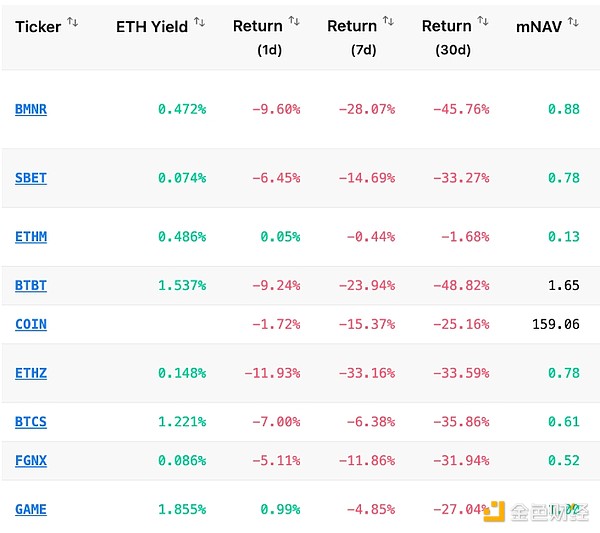
Data source: Capriole Investments
Capriole Investments data also shows that the market value to net asset value ratio (mNAV) of most of these companies (an indicator used to assess digital asset treasury valuations) has fallen below 1, indicating impaired financing ability.
According to StrategicETHreserve.xyz, since November 11, the total holdings of strategic reserves and ETFs have decreased by 280,414 ETH.
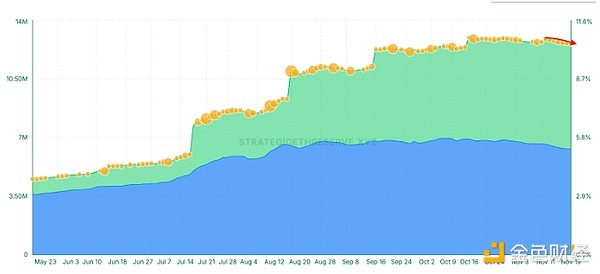
Ethereum treasury and ETF holdings reserves. Data source: StrategicETHreserve.xyz
On November 20, US-listed company DDC Enterprise announced it would purchase 300 Bitcoins, reportedly the company's largest single Bitcoin acquisition to date. After the transaction, DDC Enterprise's total Bitcoin holdings will increase to 1,383, and the company's Bitcoin yield in the second half of 2025 is expected to reach 99%.
On November 20, Metaplanet announced the issuance of $150 million in Class B perpetual preferred shares, with a fixed dividend rate of 4.9% and a conversion price of 1,000 yen, to continue increasing its Bitcoin holdings.
On November 20, Japanese listed apparel company ANAP Holding (3139.T) additionally purchased 20.44 Bitcoins, now holding a total of 1,145.68 Bitcoins.
2. Suspension
On November 19, it was reported that the $1 billion Ethereum DAT plan led by Li Lin, Shen Bo, Xiao Feng, and Cai Wensheng had been suspended, and the funds raised had been returned. This plan was the largest DAT led by Asian investors, and industry insiders speculate that the suspension was mainly due to the bear market following the 1011 event, with many DAT companies' stock prices also experiencing sharp declines recently. As for whether the plan will be restarted, relevant parties said that investors' interests would be prioritized, and the market will be observed for now, adapting to circumstances.
According to an earlier Bloomberg report, Li Lin (founder of Huobi) was working with Shen Bo (co-founder of Distributed Capital), Xiao Feng (HashKey CEO), and Cai Wensheng (founder of Meitu), among other early Asian Ethereum supporters, to set up a new digital asset trust fund, initially planning to purchase about $1 billion worth of ETH. The team was negotiating to acquire a Nasdaq-listed shell company for structuring, with funding including $200 million from Li Lin's Avenir investment company and about $500 million from Asian institutions such as Sequoia China.
3. How is Strategy Doing?
On November 17, Strategy continued to buy 8,178 BTC, bringing its total BTC holdings to 649,870.
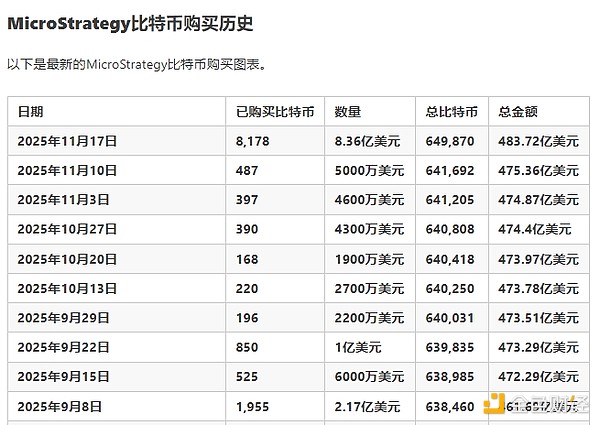
According to the latest SaylorTracker data, the market value of Bitcoin holdings by treasury company Strategy has dropped sharply to $56.11 billion, with an mNAV of 1.01. The floating profit of its 649,870 Bitcoins has fallen below $10 billion, down to $7.738 billion, and the overall yield has dropped to 16%. Strategy's average Bitcoin purchase price is now $74,433, and the current market price is only about $11,000 away from this level.
Strategy's net asset value (NAV) recently fell below 1, indicating that the market currently values the company's equity below the value of its Bitcoin holdings, which historically signals tightening liquidity and rising risk aversion. If macroeconomic conditions worsen, its $73,000 cost price being challenged again could further dampen market sentiment and trigger greater risk-off moves.
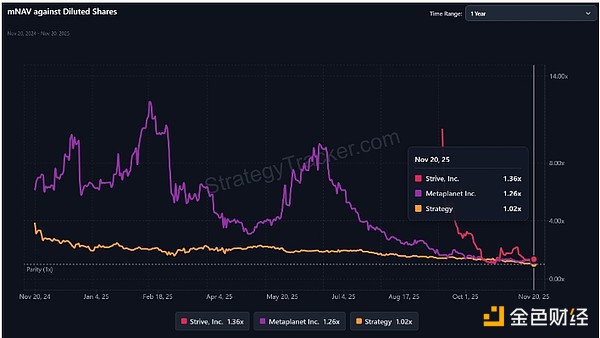
Comparison of MSTR mNAV and diluted share count. Data source: StrategyTracker
On November 19, Strategy Executive Vice President Shao Wei-Ming sold company stock again, selling 5,200 shares of MSTR at $200 each, worth $1.04 million.
III. ETF: Mainly Net Outflows for BTC and ETH
On November 18, BlackRock's iShares Bitcoin Trust (IBIT) reported its largest single-day net outflow since its listing in January 2024. IBIT ETF saw net outflows of $523.15 million, surpassing the previous record of $463 million set on November 14. IBIT is the world's largest spot Bitcoin ETF, with net assets of $72.76 billion, and has seen continuous net outflows since late October.
Vincent Liu, Chief Investment Officer of Kronos Research, believes, "The record outflows from IBIT indicate that institutional investors are making risk adjustments. Large asset allocators are reducing risk, tightening exposure, and testing entry points until macroeconomic signals become clear. Once signals are clear, risk appetite and asset allocation will recover quickly."
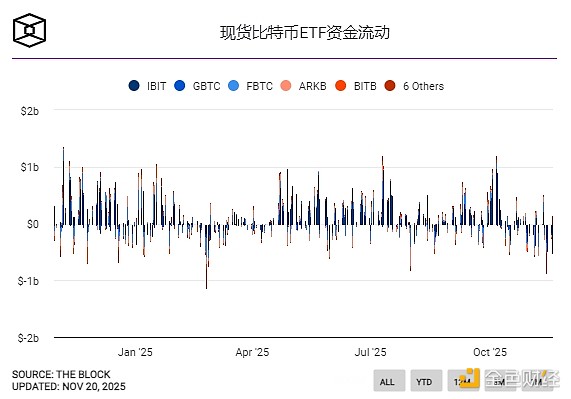
On the 18th, IBIT's $523 million outflow exceeded the inflows into Grayscale and Franklin Templeton funds, resulting in a total net outflow of $372.7 million for all spot Bitcoin ETFs that day.
Spot Ethereum ETFs are showing similar trends. BlackRock's ETHA recorded a net outflow of $165 million, exceeding the combined $91 million net inflow from Grayscale, Bitwise, VanEck, and Franklin Templeton funds.
However, the SOL ETF is experiencing net inflows. Since its launch on October 28, Bitwise's BSOL ETF has attracted $424 million, accounting for 89% of total cumulative inflows. On November 19, BSOL recorded a new net inflow of $35 million, its third-largest single-day inflow and the largest since November 3.

Bitwise Solana ETF net fund flows. Data source: SoSoValue
IV. Market Outlook
1. Positive Outlook
Renowned trader Peter Brandt stated that he does not believe Bitcoin will break $200,000 by the end of the year as some crypto industry executives have predicted. In fact, he thinks it may take nearly four more years to reach this price. In a post on X (formerly Twitter) on Thursday, Brandt said, "The next Bitcoin bull market should push its price to around $200,000, which is expected to occur around Q3 2029." He also emphasized that he is a "long-term Bitcoin bull." Brandt's prediction is notable for several reasons. Many well-known Bitcoin supporters, such as BitMEX co-founder Arthur Hayes and BitMine chairman Tom Lee, previously predicted that Bitcoin would reach at least $200,000 by the end of this year. As recently as October, Lee and Hayes reaffirmed their confidence in this forecast.
BitMine chairman Tom Lee told CNBC that the current weak crypto market is highly similar to the crash on October 10, when a stablecoin pricing error triggered the largest liquidation in history, wiping out nearly 2 million accounts and causing liquidity to dry up instantly. Lee pointed out that such deleveraging cycles usually last about eight weeks, and we are now in the sixth week, so the market may be nearing the end of its adjustment.
Bitwise Chief Investment Officer Matt Hougan refuted concerns that Bitcoin may be entering a bear market. He stated that Bitcoin's value lies in its role as a digital store of wealth "service," independent of governments, banks, or other third parties. Hougan believes that despite the recent market pullback, institutional demand for this service continues to grow, supporting Bitcoin's long-term growth trajectory.
Analyst Milk Road pointed out: "It is very likely that there will be more short-term pain ahead, but a reversal may occur within the next 2-3 weeks. Low market sentiment does not mean that new all-time highs won't be reached in the medium term."

Crypto Fear & Greed Index. Data source: CoinGlass.
2. Weakening Outlook
Crypto analysis firm Bitcoinsensus said: "For the first time since January 2023 (end of the bear market), the weekly super trend indicator has turned red." He added: "This means that, while not certain, we may be seeing the early signs of a bear market emerging." If history repeats itself, Bitcoin could fall sharply to a low of $75,000, affected by declining demand from Bitcoin treasury companies and continued outflows from US spot ETFs.
Disclaimer: The content of this article solely reflects the author's opinion and does not represent the platform in any capacity. This article is not intended to serve as a reference for making investment decisions.
You may also like
Dalio interprets "When Will the Bubble Burst": Stock Market Bubble + Huge Wealth Gap = Enormous Danger
Dalio stated that the US stock market is currently in a bubble. A bubble does not burst simply because valuations are too high; historically, what truly triggers a crash is a liquidity crisis.

Bitcoin implodes as volatility from Big Tech, AI bubble fears, spreads to crypto

How does the leading player in perpetual DEX view the future trend of HYPE?
If you believe that the trading volume of perpetual DEXs will continue to grow, then HYPE is one of the purest and most leveraged ways to capitalize on this trend.

Privacy Meets Social Trust: How UXLINK and ZEC Are Building the Next Generation of Web3 Infrastructure
As ZEC advances compliant privacy and UXLINK builds real-world social infrastructure, the industry is moving towards a safer, more inclusive, and more scalable future.
